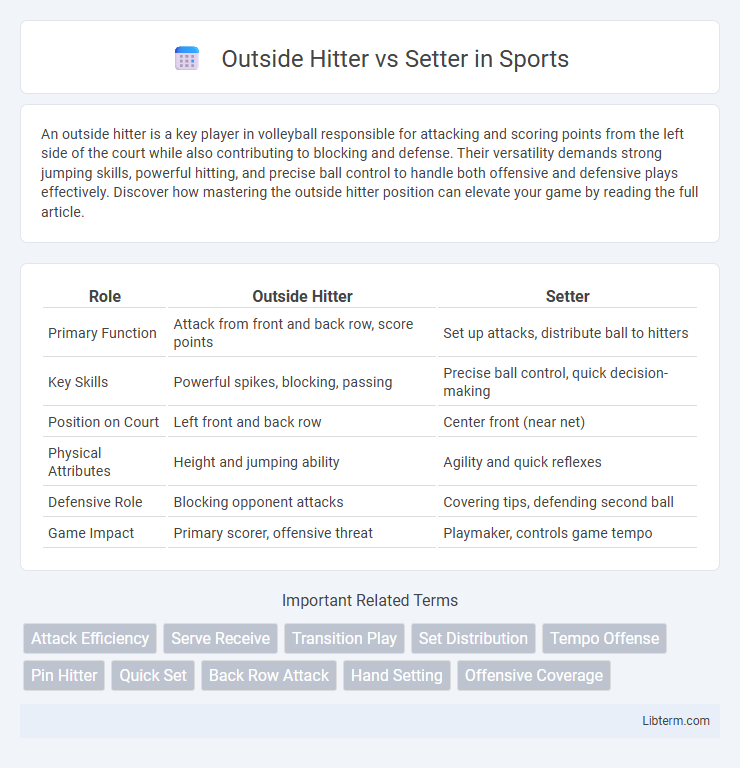An outside hitter is a key player in volleyball responsible for attacking and scoring points from the left side of the court while also contributing to blocking and defense. Their versatility demands strong jumping skills, powerful hitting, and precise ball control to handle both offensive and defensive plays effectively. Discover how mastering the outside hitter position can elevate your game by reading the full article.
Table of Comparison
| Role | Outside Hitter | Setter |
|---|---|---|
| Primary Function | Attack from front and back row, score points | Set up attacks, distribute ball to hitters |
| Key Skills | Powerful spikes, blocking, passing | Precise ball control, quick decision-making |
| Position on Court | Left front and back row | Center front (near net) |
| Physical Attributes | Height and jumping ability | Agility and quick reflexes |
| Defensive Role | Blocking opponent attacks | Covering tips, defending second ball |
| Game Impact | Primary scorer, offensive threat | Playmaker, controls game tempo |
Understanding the Roles: Outside Hitter vs Setter
The Outside Hitter specializes in powerful attacks and receives the opponent's serves, playing a crucial role in both offense and defense. The Setter acts as the team's playmaker, orchestrating offensive strategies by delivering precise sets that enable hitters to score. Understanding these roles highlights the Outside Hitter's emphasis on scoring points and passing, while the Setter focuses on ball distribution and game tempo control.
Key Responsibilities on the Court
Outside hitters are primarily responsible for powerful attacks from the left side of the court, serve reception, and blocking against opponent's right-side hitters. Setters play a crucial role in orchestrating offensive plays by delivering precise sets to attackers, managing team tempo, and making quick decisions to exploit defensive weaknesses. Both positions demand strong communication, agility, and strategic awareness to maintain effective team coordination and scoring opportunities.
Required Skills and Physical Attributes
Outside Hitters require explosive jumping ability, strong arm swing mechanics, and versatility in both offensive attacks and defensive passes. Setters need exceptional hand-eye coordination, quick decision-making skills, and precise ball placement to orchestrate offensive plays. Physical attributes for Outside Hitters emphasize height, reach, and power, while Setters benefit from agility, dexterity, and stamina to maintain consistent control during fast-paced gameplay.
Tactical Influence: How Each Position Shapes the Game
Outside hitters drive offensive momentum through powerful attacks and strategic court positioning, often targeting weak spots in the opponent's defense to maximize scoring opportunities. Setters orchestrate the game by distributing precise sets, controlling the tempo, and implementing varied offensive schemes that keep opponents off-balance. Their tactical influence shapes team dynamics, with outside hitters focusing on execution and scoring, while setters emphasize playmaking and adaptability.
Offensive vs Defensive Duties
Outside hitters primarily fulfill offensive duties by attacking from the left side, aiming to score points through powerful spikes and consistent kills. Setters have a pivotal role in offense by orchestrating plays, delivering precise sets to attackers, and creating scoring opportunities. Defensively, outside hitters contribute through blocking and floor defense, while setters focus on defending against opponent attacks and maintaining ball control to facilitate seamless offensive transitions.
Training Focus: Drills for Outside Hitters and Setters
Outside hitters prioritize training drills that enhance vertical jumping, arm swing mechanics, and approach techniques to improve attacking precision and power. Setters focus on hand positioning, footwork agility, and consistent ball placement drills to optimize setting accuracy and court vision. Both positions benefit from reaction time exercises and communication drills to synchronize team offense during fast-paced play.
Communication and Team Leadership
Outside hitters excel in dynamic communication by constantly signaling offensive options and providing feedback to setters, fostering seamless play execution. Setters act as pivotal team leaders by orchestrating attacks and making strategic decisions, maintaining clear and concise communication to synchronize the entire offense. Effective collaboration between outside hitters and setters enhances on-court chemistry, driving successful team coordination and leadership.
Career Path and Position Specialization
Outside hitters develop strong attacking skills and versatility, gaining experience in passing, blocking, and hitting, which often leads to leadership roles on the court. Setters specialize in precise ball distribution and strategic playmaking, requiring advanced knowledge of team dynamics and quick decision-making. Career progression for outside hitters often moves towards core offensive roles, while setters typically advance into pivotal positions directing game tempo and orchestrating offensive strategies.
Common Challenges and Mistakes
Outside hitters often struggle with timing and footwork when transitioning from offense to defense, leading to missed opportunities for effective attacks and blocks. Setters frequently make errors in hand positioning and decision-making under pressure, causing inaccurate sets and disrupted offensive flow. Both positions face the challenge of maintaining consistent communication and court awareness to minimize misplays and enhance team coordination.
Choosing the Right Position: Which One Suits You?
Choosing between Outside Hitter and Setter depends on your physical attributes and skill set; Outside Hitters require strong attacking and blocking abilities along with versatility in defense, while Setters need excellent hand-eye coordination, quick decision-making, and leadership to manage plays. Analyzing your strengths in ball control, agility, and strategic thinking helps determine which position enhances your performance on the court. Assessing team needs and your preferred style of play further guides the decision to excel as either an Outside Hitter or Setter.
Outside Hitter Infographic

 libterm.com
libterm.com